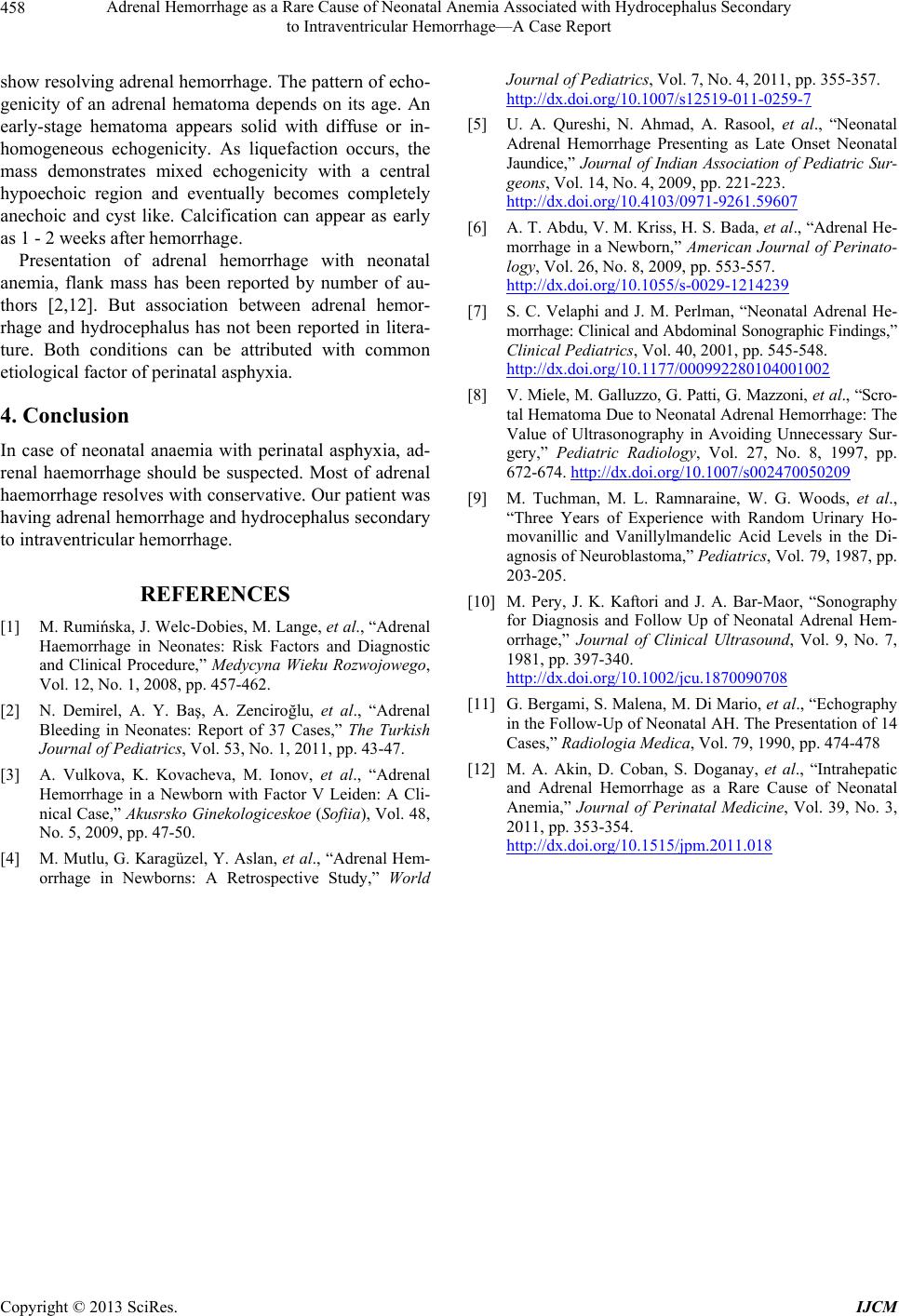
Adrenal Hemorrhage as a Rare Cause of Neonatal Anemia Associated with Hydrocephalus Secondary
to Intraventricular Hemorrhage—A Case Report
458
show resolving adrenal hemorrhage. The pattern of echo-
genicity of an adrenal hematoma depends on its age. An
early-stage hematoma appears solid with diffuse or in-
homogeneous echogenicity. As liquefaction occurs, the
mass demonstrates mixed echogenicity with a central
hypoechoic region and eventually becomes completely
anechoic and cyst like. Calcification can appear as early
as 1 - 2 weeks after hemorrhage.
Presentation of adrenal hemorrhage with neonatal
anemia, flank mass has been reported by number of au-
thors [2,12]. But association between adrenal hemor-
rhage and hydrocephalus has not been reported in litera-
ture. Both conditions can be attributed with common
etiological factor of perinatal asphyxia.
4. Conclusion
In case of neonatal anaemia with perinatal asphyxia, ad-
renal haemorrhage should be suspected. Most of adrenal
haemorrhage resolves with conservative. Our patient was
having adrenal hemorrhage and hydrocephalus secondary
to intraventricular hemorrhage.
REFERENCES
[1] M. Rumińska, J. Welc-Dobies, M. Lange, et al., “Adrenal
Haemorrhage in Neonates: Risk Factors and Diagnostic
and Clinical Procedure,” Medycyna Wieku Rozwojowego,
Vol. 12, No. 1, 2008, pp. 457-462.
[2] N. Demirel, A. Y. Baş, A. Zenciroğlu, et al., “Adrenal
Bleeding in Neonates: Report of 37 Cases,” The Turkish
Journal of Pediatrics, Vol. 53, No. 1, 2011, pp. 43-47.
[3] A. Vulkova, K. Kovacheva, M. Ionov, et al., “Adrenal
Hemorrhage in a Newborn with Factor V Leiden: A Cli-
nical Case,” Akusrsko Ginekologiceskoe (Sofiia), Vol. 48,
No. 5, 2009, pp. 47-50.
[4] M. Mutlu, G. Karagüzel, Y. Aslan, et al., “Adrenal Hem-
orrhage in Newborns: A Retrospective Study,” World
Journal of Pediatrics, Vol. 7, No. 4, 2011, pp. 355-357.
http://dx.doi.org/10.1007/s12519-011-0259-7
[5] U. A. Qureshi, N. Ahmad, A. Rasool, et al., “Neonatal
Adrenal Hemorrhage Presenting as Late Onset Neonatal
Jaundice,” Journal of Indian Association of Pediatric Sur-
geons, Vol. 14, No. 4, 2009, pp. 221-223.
http://dx.doi.org/10.4103/0971-9261.59607
[6] A. T. Abdu, V. M. Kriss, H. S. Bada, et al ., “Adrenal He-
morrhage in a Newborn,” American Journal of Perinato-
logy, Vol. 26, No. 8, 2009, pp. 553-557.
http://dx.doi.org/10.1055/s-0029-1214239
[7] S. C. Velaphi and J. M. Perlman, “Neonatal Adrenal He-
morrhage: Clinical and Abdominal Sonographic Findings,”
Clinical P ediatrics, Vol. 40, 2001, pp. 545-548.
http://dx.doi.org/10.1177/000992280104001002
[8] V. Miele, M. Galluzzo, G. Patti, G. Mazzoni, et al., “Scro-
tal Hematoma Due to Neonatal Adrenal Hemorrhage: The
Value of Ultrasonography in Avoiding Unnecessary Sur-
gery,” Pediatric Radiology, Vol. 27, No. 8, 1997, pp.
672-674. http://dx.doi.org/10.1007/s002470050209
[9] M. Tuchman, M. L. Ramnaraine, W. G. Woods, et al.,
“Three Years of Experience with Random Urinary Ho-
movanillic and Vanillylmandelic Acid Levels in the Di-
agnosis of Neuroblastoma,” Pediatrics, Vol. 79, 1987, pp.
203-205.
[10] M. Pery, J. K. Kaftori and J. A. Bar-Maor, “Sonography
for Diagnosis and Follow Up of Neonatal Adrenal Hem-
orrhage,” Journal of Clinical Ultrasound, Vol. 9, No. 7,
1981, pp. 397-340.
http://dx.doi.org/10.1002/jcu.1870090708
[11] G. Bergami, S. Malena, M. Di Mario, et al., “Echography
in the Follow-Up of Neonatal AH. The Presentation of 14
Cases,” Radiol ogia M edica, Vol. 79, 1990, pp. 474-478
[12] M. A. Akin, D. Coban, S. Doganay, et al., “Intrahepatic
and Adrenal Hemorrhage as a Rare Cause of Neonatal
Anemia,” Journal of Perinatal Medicine, Vol. 39, No. 3,
2011, pp. 353-354.
http://dx.doi.org/10.1515/jpm.2011.018
Copyright © 2013 SciRes. IJCM